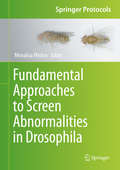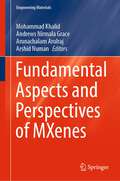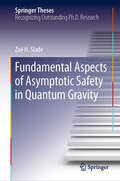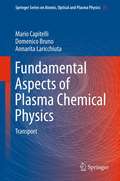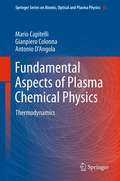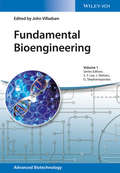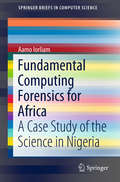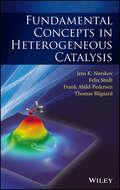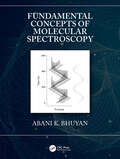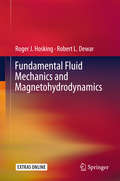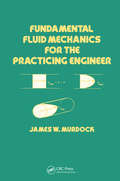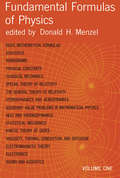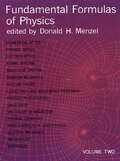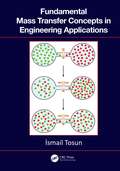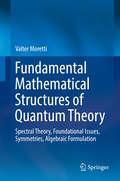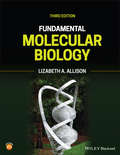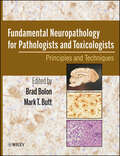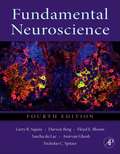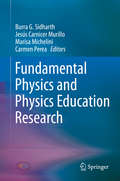- Table View
- List View
Fundamental Approaches to Screen Abnormalities in Drosophila (Springer Protocols Handbooks)
by Monalisa MishraThis volume includes in-depth, hands-on protocols for detecting various developmental defects in Drosophila. It provides cutting-edge methods for maintaining Drosophila under laboratory conditions to perform various experiments, and for dissecting various imaginal discs of the larvae. Further, biochemical protocols for estimating the levels of different metabolites, reactive oxygen species, and fat-sensitive pathways are discussed, and various staining and behavior techniques for fat detection are provided. The book explains how various fluorescent dyes and the comet assay can be used to identify DNA damage, and elaborates on the analysis of the eye, antennae, imaginal disc, gut and muscle damage under bright field and fluorescent microscopes. It covers the analysis of hemolymph using Giemsa staining; determining the functionality of channel proteins, eye and mechanosensory organs in adults and larvae using various behavioral assays; and metal detection and structural analysis for various tissues using SEM. In closing, it addresses the analysis of Drosophila’s eye and head via paraffin section; measurement of reactive oxygen species from various tissues via FACS; and the CRISPER technique for gene editing and analysis of micro RNA mutations.
Fundamental Aspects and Perspectives of MXenes (Engineering Materials)
by Mohammad Khalid Arshid Numan Andrews Nirmala Grace Arunachalam ArulrajThis book presents the fundamental aspects, recent developments in fabrication and characterization techniques, structure, properties, and emerging applications of MXenes. It shows the advancement in scale-up, challenges, and their futuristic perspectives. An overview of all the latest developments in energy storage and conversion applications, catalysis, environmental remediation, and radiation shielding, etc is reported.
Fundamental Aspects of Asymptotic Safety in Quantum Gravity (Springer Theses)
by Zoë H. SladeAfter an extensive introduction to the asymptotic safety approach to quantum gravity, this thesis explains recent key advances reported in four influential papers. Firstly, two exact solutions to the reconstruction problem (how to recover a bare action from the effective average action) are provided. Secondly, the fundamental requirement of background independence in quantum gravity is successfully implemented. Working within the derivative expansion of conformally reduced gravity, the notion of compatibility is developed, uncovering the underlying reasons for background dependence generically forbidding fixed points in such models. Thirdly, in order to understand the true nature of fixed-point solutions, one needs to study their asymptotic behaviour. The author carefully explains how to find the asymptotic form of fixed point solutions within the f(R) approximation. Finally, the key findings are summarised and useful extensions of the work are identified. The thesis finishes by considering the need to incorporate matter into the formalism in a compatible way and touches upon potential opportunities to test asymptotic safety in the future.
Fundamental Aspects of Plasma Chemical Physics
by Annarita Laricchiuta Domenico Bruno Mario CapitelliFundamental Aspects of Plasma Chemical Physics: Transport develops basic and advanced concepts of plasma transport to the modern treatment of the Chapman-Enskog method for the solution of the Boltzmann transport equation. The book invites the reader to consider actual problems of the transport of thermal plasmas with particular attention to the derivation of diffusion- and viscosity-type transport cross sections, stressing the role of resonant charge-exchange processes in affecting the diffusion-type collision calculation of viscosity-type collision integrals. A wide range of topics is then discussed including (1) the effect of non-equilibrium vibrational distributions on the transport of vibrational energy, (2) the role of electronically excited states in the transport properties of thermal plasmas, (3) the dependence of transport properties on the multitude of Saha equations for multi-temperature plasmas, and (4) the effect of the magnetic field on transport properties. Throughout the book, worked examples are provided to clarify concepts and mathematical approaches. This book is the second of a series of three published by the Bari group on fundamental aspects of plasma chemical physics. The first book, Fundamental Aspects of Plasma Chemical Physics: Thermodynamics, is dedicated to plasma thermodynamics; and the third, Fundamental Aspects of Plasma Chemical Physics: Kinetics, deals with plasma kinetics.
Fundamental Aspects of Plasma Chemical Physics
by Annarita Laricchiuta Mario Capitelli Gianpiero Colonna Roberto Celiberto Fabrizio Esposito Claudine Gorse Khaled Hassouni Savino LongoDescribing non-equilibrium "cold" plasmas through a chemical physics approach, this book uses the state-to-state plasma kinetics, which considers each internal state as a new species with its own cross sections. Extended atomic and molecular master equations are coupled with Boltzmann and Monte Carlo methods to solve the electron energy distribution function. Selected examples in different applied fields, such as microelectronics, fusion, and aerospace, are presented and discussed including the self-consistent kinetics in RF parallel plate reactors, the optimization of negative ion sources and the expansion of high enthalpy flows through nozzles of different geometries. The book will cover the main aspects of the state-to-state kinetic approach for the description of nonequilibrium cold plasmas, illustrating the more recent achievements in the development of kinetic models including the self-consistent coupling of master equations and Boltzmann equation for electron dynamics. To give a complete portrayal, the book will assess fundamental concepts and theoretical formulations, based on a unified methodological approach, and explore the insight in related scientific problems still opened for the research community.
Fundamental Aspects of Plasma Chemical Physics
by Mario Capitelli Gianpiero Colonna Antonio D'AngolaFundamental Aspects of Plasma Chemical Physics - Thermodynamics develops basic and advanced concepts of plasma thermodynamics from both classical and statistical points of view. After a refreshment of classical thermodynamics applied to the dissociation and ionization regimes, the book invites the reader to discover the role of electronic excitation in affecting the properties of plasmas, a topic often overlooked by the thermal plasma community. Particular attention is devoted to the problem of the divergence of the partition function of atomic species and the state-to-state approach for calculating the partition function of diatomic and polyatomic molecules. The limit of ideal gas approximation is also discussed, by introducing Debye-Huckel and virial corrections. Throughout the book, worked examples are given in order to clarify concepts and mathematical approaches. This book is a first of a series of three books to be published by the authors on fundamental aspects of plasma chemical physics. The next books will discuss transport and kinetics.
Fundamental Astronomy
by Hannu Karttunen Pekka Kröger Heikki Oja Markku Poutanen Karl Johan DonnerThe main purpose of this book is to serve as a university textbook for a first course in astronomy. However, we believe that the audience will also include many serious ama teurs, who often find the popular texts too trivial. The lack of a good handbook for am ateurs has become a problem lately, as more and more people are buying personal com puters and need exact, but comprehensible, mathematical formalism for their programs. The reader of this book is assumed to have only a standard high-school knowledge of mathematics and physics (as they are taught in Finland); everything more advanced is usually derived step by step from simple basic principles. The mathematical background needed includes plane trigonometry, basic differential and integral calculus, and (only in the chapter dealing with celestial mechanics) some vector calculus. Some mathematical concepts the reader may not be familiar with are briefly explained in the appendices or can be understood by studying the numerous exercises and examples. However, most of the book can be read with very little knowledge of mathematics, and even if the reader skips the mathematically more involved sections, (s)he should get a good overview of the field of astronomy. This book has evolved in the course of many years and through the work of several authors and editors. The first version consisted of lecture notes by one of the editors (Oja).
Fundamental Bioengineering
by Jens Nielsen John Villadsen Gregory Stephanopoulos Sang Yup LeeA thorough introduction to the basics of bioengineering, with a focus on applications in the emerging "white" biotechnology industry. As such, this latest volume in the "Advanced Biotechnology" series covers the principles for the design and analysis of industrial bioprocesses as well as the design of bioremediation systems, and several biomedical applications. No fewer than seven chapters introduce stoichiometry, kinetics, thermodynamics and the design of ideal and real bioreactors, illustrated by more than 50 practical examples. Further chapters deal with the tools that enable an understanding of the behavior of cell cultures and enzymatically catalyzed reactions, while others discuss the analysis of cultures at the level of the cell, as well as structural frameworks for the successful scale-up of bioreactions. In addition, a short survey of downstream processing options and the control of bioreactions is given.With contributions from leading experts in industry and academia, this is a comprehensive source of information peer-reviewed by experts in the field.
Fundamental Computing Forensics for Africa: A Case Study of the Science in Nigeria (SpringerBriefs in Computer Science)
by Aamo IorliamThis book presents a general introduction to the computational aspects of forensic science, covering the different tools needed for forensic investigations, the importance of forensics and biometrics, and the use of Benford’s law for biometrics and network traffic analysis. It specifically focuses on the application of these techniques in Africa, and how they can be of benefit in the investigation of crime in Nigeria in particular.
Fundamental Concepts in Heterogeneous Catalysis
by Thomas Bligaard Jens K. Nørskov Felix Studt Frank Abild-PedersenThis book is based on a graduate course and suitable as a primer for any newcomer to the field, this book is a detailed introduction to the experimental and computational methods that are used to study how solid surfaces act as catalysts. Features include: First comprehensive description of modern theory of heterogeneous catalysis Basis for understanding and designing experiments in the field Allows reader to understand catalyst design principles Introduction to important elements of energy transformation technology Test driven at Stanford University over several semesters
Fundamental Concepts of Molecular Spectroscopy
by Abani K BhuyanThis practical and unique textbook explains the core areas of molecular spectroscopy as a classical teacher would, from the perspective of both theory and experimental practice. Comprehensive in scope, the author carefully explores and explains each concept, walking side by side with the student through carefully constructed text, pedagogy, and derivations to ensure comprehension of the basics before approaching higher level topics. The author incorporates both electric resonance and magnetic resonance in the textbook.
Fundamental Fluid Mechanics and Magnetohydrodynamics
by Roger J. Hosking Robert L. DewarThis book is primarily intended to enable postgraduate research students to enhance their understanding and expertise in Fluid Mechanics and Magnetohydrodynamics (MHD), subjects no longer treated in isolation. The exercises throughout the book often serve to provide additional and quite significant knowledge or to develop selected mathematical skills, and may also fill in certain details or enhance readers' understanding of essential concepts. A previous background or some preliminary reading in either of the two core subjects would be advantageous, and prior knowledge of multivariate calculus and differential equations is expected.
Fundamental Fluid Mechanics for the Practicing Engineer (Mechanical Engineering)
by James W. MurdockA step-by-step guide, containing tutorial examples that serve as models for all concepts presented. This text contains properties of nearly 50 fluids, including density and viscosity data for compressed water and superheated steam, and characteristics of areas, pipes and tubing.
Fundamental Formulas of Physics, Volume One
by Donald H. MenzelThe republication of this book, unabridged and corrected, fills the need for a comprehensive work on fundamental formulas of mathematical physics. It ranges from simple operations to highly sophisticated ones, all presented most lucidly with terms carefully defined and formulas given completely. In addition to basic physics, pertinent areas of chemistry, astronomy, meteorology, biology, and electronics are also included.This is no mere listing of formulas, however. Mathematics is integrated into text, for the most part, so that each chapter stands as a brief summary or even short textbook of the field represented. The book, therefore, fills other needs than the primary function of reference and guide for research. The student will find it a handy review of familiar fields and an aid to gaining rapid insight into the techniques of new ones.The teacher will study it as a useful guide to a broad concept of physics. The chemist, astronomer, meteorologist, biologist, and engineer will not only derive valuable aid from their special chapters, but will understand how their specialty fits into the large scheme of physics.Vol. 1 chapter titles: Basic Mathematical Formulas, Statistics, Nomograms, Physical Constants, Classical Mechanics, Special Theory of Relativity, The General Theory of Relativity, Hydrodynamics and Aerodynamics, Boundary Value Problems in Mathematical Physics, Heat and Thermodynamics, Statistical Mechanics, Kinetic Theory of Gases: Viscosity, Thermal Conduction, and Diffusion, Electromagnetic Theory, Electronics, Sound and Acoustics.Vol. 2 chapter titles: Geometrical Optics, Physical Optics, Electron Optics, Molecular Spectra, Atomic Spectra, Quantum Mechanics, Nuclear Theory, Cosmic Rays and High-Energy Phenomena, Particle Accelerators, Solid State, Theory of Magnetism, Physical Chemistry, Basic Formulas of Astrophysics, Celestial Mechanics, Meteorology, Biophysics.
Fundamental Formulas of Physics, Volume Two (Dover Books on Physics #2)
by Donald H. MenzelThe republication of this book, unabridged and corrected, fills the need for a comprehensive work on fundamental formulas of mathematical physics. It ranges from simple operations to highly sophisticated ones, all presented most lucidly with terms carefully defined and formulas given completely. In addition to basic physics, pertinent areas of chemistry, astronomy, meteorology, biology, and electronics are also included.This is no mere listing of formulas, however. Mathematics is integrated into text, for the most part, so that each chapter stands as a brief summary or even short textbook of the field represented. The book, therefore, fills other needs than the primary function of reference and guide for research. The student will find it a handy review of familiar fields and an aid to gaining rapid insight into the techniques of new ones.The teacher will study it as a useful guide to a broad concept of physics. The chemist, astronomer, meteorologist, biologist, and engineer will not only derive valuable aid from their special chapters, but will understand how their specialty fits into the large scheme of physics.Vol. 1 chapter titles: Basic Mathematical Formulas, Statistics, Nomograms, Physical Constants, Classical Mechanics, Special Theory of Relativity, The General Theory of Relativity, Hydrodynamics and Aerodynamics, Boundary Value Problems in Mathematical Physics, Heat and Thermodynamics, Statistical Mechanics, Kinetic Theory of Gases: Viscosity, Thermal Conduction, and Diffusion, Electromagnetic Theory, Electronics, Sound and Acoustics.Vol. 2 chapter titles: Geometrical Optics, Physical Optics, Electron Optics, Molecular Spectra, Atomic Spectra, Quantum Mechanics, Nuclear Theory, Cosmic Rays and High-Energy Phenomena, Particle Accelerators, Solid State, Theory of Magnetism, Physical Chemistry, Basic Formulas of Astrophysics, Celestial Mechanics, Meteorology, Biophysics.
Fundamental Issues in Defense Training and Simulation (Human Factors in Defence)
by George Galanis Robert SottilareDefense forces have always invested a great deal of their resources in training. In recent times, changes in the complexity and intensity of operations have reaffirmed the importance of ensuring that warfighters are adequately prepared for the environments in which they are required to work. The emergence of new operational drivers such as asymmetric threats, urban operations, joint and coalition operations and the widespread use of military communications and information technology networks has highlighted the importance of providing warfighters with the competencies required to act in a coordinated, adaptable fashion, and to make effective decisions in environments characterized by large amounts of sometimes ambiguous information. While investment in new technologies can make available new opportunities for action, it is only through effective training that personnel can be made ready to apply their tools in the most decisive and discriminating fashion. There are many factors which can have an impact on the efficacy of training and many issues to consider when designing and implementing training strategies. These issues are often complex and nuanced, and in order to grasp them fully a significant investment of time and energy is required. However, the requirement to respond quickly to ever-changing technology, a high operational tempo and minimal staffing may preclude many in today's defense forces from seeking out all such resources on their own. This edited collection provides brief, easy-to-understand summaries of the key issues in defense training and simulation, as well as guidance for further reading. It consists of a collection of short essays, each of which addresses a fundamental issue in defense training and simulation, and features an up-to-date reference list to enable the reader to undertake further investigation of the issues addressed. In essence, this book provides the optimum starting point, or first resource, for readers to come to terms with the important issues associated with defense training and simulation. The contributions are written by leading scholars from military research institutions in the US, UK, Canada, Australia and New Zealand, as well as selected researchers from academic and private sector research institutions.
Fundamental Mass Transfer Concepts in Engineering Applications
by Ismail TosunFundamental Mass Transfer Concepts in Engineering Applications provides the basic principles of mass transfer to upper undergraduate and graduate students from different disciplines. This book outlines foundational material and equips students with sufficient mathematical skills to tackle various engineering problems with confidence. It covers mass transfer in both binary and multicomponent systems and integrates the use of Mathcad® for solving problems. This textbook is an ideal resource for a one-semester course. Key Features The concepts are explained with the utmost clarity in simple and elegant language Presents theory followed by a variety of practical, fully-worked example problems Includes a summary of the mathematics necessary for mass transfer calculations in an appendix Provides ancillary Mathcad® subroutines Includes end-of-chapter problems and a solutions manual for adopting instructors
Fundamental Mathematical Structures of Quantum Theory: Spectral Theory, Foundational Issues, Symmetries, Algebraic Formulation
by Valter MorettiThis textbook presents in a concise and self-contained way the advanced fundamental mathematical structures in quantum theory. It is based on lectures prepared for a 6 months course for MSc students. The reader is introduced to the beautiful interconnection between logic, lattice theory, general probability theory, and general spectral theory including the basic theory of von Neumann algebras and of the algebraic formulation, naturally arising in the study of the mathematical machinery of quantum theories. Some general results concerning hidden-variable interpretations of QM such as Gleason's and the Kochen-Specker theorems and the related notions of realism and non-contextuality are carefully discussed. This is done also in relation with the famous Bell (BCHSH) inequality concerning local causality.Written in a didactic style, this book includes many examples and solved exercises.The work is organized as follows. Chapter 1 reviews some elementary facts and properties of quantum systems. Chapter 2 and 3 present the main results of spectral analysis in complex Hilbert spaces. Chapter 4 introduces the point of view of the orthomodular lattices' theory. Quantum theory form this perspective turns out to the probability measure theory on the non-Boolean lattice of elementary observables and Gleason's theorem characterizes all these measures. Chapter 5 deals with some philosophical and interpretative aspects of quantum theory like hidden-variable formulations of QM. The Kochen-Specker theorem and its implications are analyzed also in relation BCHSH inequality, entanglement, realism, locality, and non-contextuality. Chapter 6 focuses on the algebra of observables also in the presence of superselection rules introducing the notion of von Neumann algebra. Chapter 7 offers the idea of (groups of) quantum symmetry, in particular, illustrated in terms of Wigner and Kadison theorems. Chapter 8 deals with the elementary ideas and results of the so called algebraic formulation of quantum theories in terms of both *-algebras and C*-algebras.This book should appeal to a dual readership: on one hand mathematicians that wish to acquire the tools that unlock the physical aspects of quantum theories; on the other physicists eager to solidify their understanding of the mathematical scaffolding of quantum theories.
Fundamental Mathematics and Physics of Medical Imaging (Series in Medical Physics and Biomedical Engineering)
by Jack Lancaster Bruce HasegawaAuthored by a leading educator, this book teaches the fundamental mathematics and physics concepts associated with medical imaging systems. Going beyond mere description of imaging modalities, this book delves into the mechanisms of image formation and image quality common to all imaging systems: contrast mechanisms, noise, and spatial and temporal resolution, making it an important reference for medical physicists and biomedical engineering students. This is an extensively revised new edition of The Physics of Medical X-Ray Imaging by Bruce Hasegawa (Medical Physics Publishing, 1991), and includes a wide range of modalities such as X-ray CT, MRI and SPECT.
Fundamental Medical Mycology
by G. Marshall Lyon Errol Reiss H. Jean ShadomyMedical mycology deals with those infections in humans, and animals resulting from pathogenic fungi. As a separate discipline, the concepts, methods, diagnosis, and treatment of fungal diseases of humans are specific. Incorporating the very latest information concerning this area of vital interest to research and clinical microbiologists,Fundamental Medical Mycology balances clinical and laboratory knowledge to provide clinical laboratory scientists, medical students, interns, residents, and fellows with in-depth coverage of each fungal disease and its etiologic agents from both the laboratory and clinical perspective. Richly illustrated throughout, the book includes numerous case presentations.
Fundamental Molecular Biology
by Lizabeth A. AllisonWhile there is an innate fascination and interest in how our own genes influence our lives, molecular biology students are daunted by the amount of information they need to assimilate in order to succeed in the course. And, with the fast pace of discovery in the field, it is difficult to find suitable, up to date texts for the course-they are either too advanced, comprehensive and overwhelming detailed, or they are too basic, superficial, and less experimental in their approach. Instructors find it difficult to decide what topics are the most important to include and exclude in the course when presented with an extensive array of choices.Fundamental Molecular Biology is selective in its coverage and presents essential topics that allow students to develop an understanding of how molecular biology is applied to the analysis of complex systems. Through the process of discovery-- observations, questions, experimental designs, results and conclusions-and with an emphasis on the language of molecular biology, students can focus on the key ideas they need to succeed in the course. Students will also have the support they need outside the classroom to leave your course knowing the core, fundamental concepts of molecular biology delivered through a visually engaging, and focused text with a rich media program that promotes self-study.With a strong emphasis on biomedical research and discovery, students are exposed to both classic and the most up to date techniques and research in molecular biology today. Our book encourages reading and discovery through in-text tools, and media tools.
Fundamental Neuropathology for Pathologists and Toxicologists
by Brad Bolon Mark T. ButtThis book offers pathologists, toxicologists, other medical professionals, and students an introduction to the discipline and techniques of neuropathology - including chemical and environmental, biological, medical, and regulatory details important for performing an analysis of toxicant-induced neurodiseases. In addition to a section on fundamentals, the book provides detailed coverage of current practices (bioassays, molecular analysis, and nervous system pathology) and practical aspects (data interpretation, regulatory considerations, and tips for preparing reports).
Fundamental Neuroscience, 4th Edition
by Nicholas C. Spitzer Floyd E. Bloom Larry Squire Darwin Berg Sascha Du Lac Anirvan GhoshThe fourth edition of Fundamental Neuroscience reinvents itself as an engrossing and comprehensive presentation of the discipline of neuroscience, from molecules to cognition. Thorough but succinct, and lavishly illustrated, the book builds from an introductory section that includes fundamental neuroanatomy and goes on to cover cellular and molecular neuroscience, development, sensory systems, motor systems, regulatory systems, and behavioral and cognitive neuroscience. The book has been retooled to better serve its audience in the neuroscience and medical communities. The chapters include more than 100 boxes describing clinical conditions, techniques, and other special topics. Each chapter went through a thorough review process, giving the book an evenness of tone. The chapters are authored by outstanding working scientists who are experts on the topics they cover. Selected for inclusion in Doody's Core Titles 2013, an essential collection development tool for health sciences libraries 30% new material including new chapters on dendritic development and spine morphogenesis, chemical senses, cerebellum, eye movements, circadian timing, sleep and dreaming, and consciousness Accompanying website for students and instructors Additional text boxes describing key experiments, disorders, methods, and concepts More than 650 four-color illustrations, micrographs, and neuroimages Multiple model system coverage beyond rats, mice, and monkeys Extensively expanded index for easier referencing
Fundamental Neuroscience, Second Edition
by Larry R. Squire James L. Roberts Nicholas C. Spitzer Michael J. Zigmond Susan K. Mcconnell Floyd E. BloomA definitive text in neuroscience.
Fundamental Physics and Physics Education Research (Springer Proceedings In Physics Ser. #145)
by Burra G. Sidharth Marisa Michelini Jesús Carnicer Murillo Carmen PereaThis book highlights selected contributions presented at the 15th annual international symposium Frontiers of Fundamental Physics (FFP15), with the aim of informing readers about the most important recent advances in fundamental physics and physics education research. The FFP series offers a platform for physicists from around the world to present their latest theories and findings. The latest symposium was held in Orihuela, Spain and covered diverse fields of research, including gravitation, astronomy and astrophysics, physics of complex systems, high-energy physics, and mathematical physics. Considerable attention was also paid to physics education research, teacher education in physics, and the popularization of physics. In a knowledge-based society, research into fundamental physics plays a vital role in both the advancement of human knowledge and the development of new technologies. Presenting valuable new peer-reviewed contributions submitted from 15 countries, this book will appeal to a broad audience of scholars and researchers.
